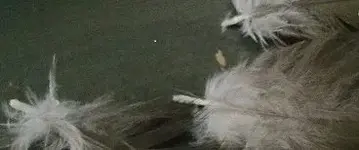Hey guys,
Should I be concerned about my male ekkie's feather preening?
I've seen my ekkie preen himself but I never thought it seemed excessive. He has no bald spots.
Today I noticed when he was hanging out with me uncaged; there were a few feathers on the floor. I figured they might have been loose anyway or molting and didn't think much of it. Then I kept seeing more feathers. Although these are not large feathers, the feathers I'm used to seeing are the grey downy ones (upper right corner of pic), not actual green feathers, (at least not so many at once). Has he now crossed the line from preening into plucking? Or is this all part of the molting process?
I have not actually witnessed him plucking. However, I saw him holding a separated (not sure if it was plucked or already “loose”) feather with one foot and would really focus on preening it. (He was sitting on a perch, so I know that he did not get that feather from the floor). When I first saw him doing it, I admonished him and took the feather away and replaced it with something he could chew. Still, I saw him doing it again later. Prior to today, I've never seen him do that before. Is this normal? If not, how do I handle it? He was in my presence, uncaged, during this whole time.
I don't want him to get in the habit of plucking feathers just to preen them. He has wooden chew toys, designated paper/cardboard, and foot toys he can chew. So, he's not lacking for things to chew on.
Attached is a pic of the green feathers I found today, minus two or three I threw away earlier before I started keeping track. This was over a span of maybe 3 hours on and off in the same area. But I'm not sure if the feathers were accumulating the whole time or just within that last hour or so. Upper right is a grey downy one that I’m used to seeing everywhere. I just included one in the pic for reference. Are there too many green feathers? I don't recall seeing that many in that span of time before.
So to sum it up: Would molting lead to that number of loose green feathers or is it plucking? Would he pluck a feather if it was molting?
What to do about him holding and preening his feathers after plucking or molting it off?
Should I be concerned about my male ekkie's feather preening?
I've seen my ekkie preen himself but I never thought it seemed excessive. He has no bald spots.
Today I noticed when he was hanging out with me uncaged; there were a few feathers on the floor. I figured they might have been loose anyway or molting and didn't think much of it. Then I kept seeing more feathers. Although these are not large feathers, the feathers I'm used to seeing are the grey downy ones (upper right corner of pic), not actual green feathers, (at least not so many at once). Has he now crossed the line from preening into plucking? Or is this all part of the molting process?
I have not actually witnessed him plucking. However, I saw him holding a separated (not sure if it was plucked or already “loose”) feather with one foot and would really focus on preening it. (He was sitting on a perch, so I know that he did not get that feather from the floor). When I first saw him doing it, I admonished him and took the feather away and replaced it with something he could chew. Still, I saw him doing it again later. Prior to today, I've never seen him do that before. Is this normal? If not, how do I handle it? He was in my presence, uncaged, during this whole time.
I don't want him to get in the habit of plucking feathers just to preen them. He has wooden chew toys, designated paper/cardboard, and foot toys he can chew. So, he's not lacking for things to chew on.
Attached is a pic of the green feathers I found today, minus two or three I threw away earlier before I started keeping track. This was over a span of maybe 3 hours on and off in the same area. But I'm not sure if the feathers were accumulating the whole time or just within that last hour or so. Upper right is a grey downy one that I’m used to seeing everywhere. I just included one in the pic for reference. Are there too many green feathers? I don't recall seeing that many in that span of time before.
So to sum it up: Would molting lead to that number of loose green feathers or is it plucking? Would he pluck a feather if it was molting?
What to do about him holding and preening his feathers after plucking or molting it off?
Attachments
Last edited:

